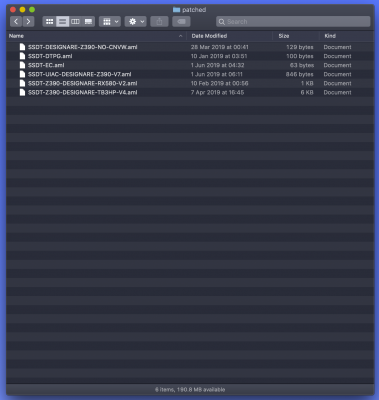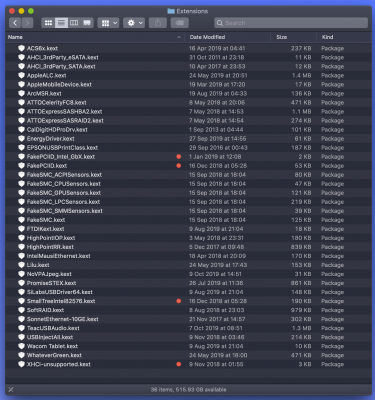- Joined
- Oct 3, 2013
- Messages
- 243
- Motherboard
- Asus TUF Gaming Z790-Plus WIFI
- CPU
- i7-14700K
- Graphics
- RX 6900 XT
- Mobile Phone
@CaseySJ, have a question or 2... 
I manually created my own config and got everything up and running on Mojave 10.14.6. Preparing to install Catalina, but getting all the system work done before hand, creating SMBIOS, creating any SSDT etc.
A few questions:
1. Does your RX580 SSDT do anything other than list the device under PCI section? I copied the SSDT from the Post folder, but it isn't doing anything, PCI section still showed empty. Of course, this may be because I have an RX 590 and not 580 lol, so no surprise there. I'm just wondering if your SSDT does anything else that would help performance wise or in some other way (I checked the SSDT code and noticed you have other methods in there).
I actually added my RX 590 and other installed PCI cards to the PCI list using the properties section of my config.plist, since I'm comfortable and used to doing it that way
2. If I remove the Intel WIFI card (plan to use it on a motherboard for a Windows build), do I still need to use the SSDT to remove it? If so, how can I verify that it is working properly? Is looking at the PCI list in Hackintool (for example) or IORegistryExplorer enough?
Edit: NVM question 2, as logic dictates and I just confirmed by reading a few posts by you quite a few pages back, removing the card should be followed by removing the SSDT lol...
3. I would like to modify the SSDT for UIA, to use the ports I use. I saw you mentioned the power properties and saw that code in the UIA SSDT. Can I just edit the port section of the SSDT and use it as is, or would I need to do anything different to inject power properties for my custom port layout? Or could I just copy the relevant power properties section from your SSDT to mine to get the full USB power? If you don't feel like rewriting all of that (since your guide already has the work done), do you by chance have or know of a guide to do this properly? I don't recall if RehabMan's port injection guide dealt with power properties injection, will have to take a second look
4. Do you have any update on FakeSMC VS VirtualSMC? I don't really use sensor reading apps or anything like that under macOS; I do my overclocking under Windows Do I gain anything by switching to VirtualSMC? Currently using FakeSMC and OsxAptioFix2Drv-free2000. If VirtualSMC would get AptioMemoryFix working, that may be worth it, as it supposedly allows for native NVRAM on most Z390 boards. Last time I tried it on my Z390 Pro build, it was no go lol...
Do I gain anything by switching to VirtualSMC? Currently using FakeSMC and OsxAptioFix2Drv-free2000. If VirtualSMC would get AptioMemoryFix working, that may be worth it, as it supposedly allows for native NVRAM on most Z390 boards. Last time I tried it on my Z390 Pro build, it was no go lol...
I noticed memory fix drivers were a hot topic some pages ago, but couldn't quite gather a conclusion on the matter
Thanks for any info you can provide!
I manually created my own config and got everything up and running on Mojave 10.14.6. Preparing to install Catalina, but getting all the system work done before hand, creating SMBIOS, creating any SSDT etc.
A few questions:
1. Does your RX580 SSDT do anything other than list the device under PCI section? I copied the SSDT from the Post folder, but it isn't doing anything, PCI section still showed empty. Of course, this may be because I have an RX 590 and not 580 lol, so no surprise there. I'm just wondering if your SSDT does anything else that would help performance wise or in some other way (I checked the SSDT code and noticed you have other methods in there).
I actually added my RX 590 and other installed PCI cards to the PCI list using the properties section of my config.plist, since I'm comfortable and used to doing it that way
2. If I remove the Intel WIFI card (plan to use it on a motherboard for a Windows build), do I still need to use the SSDT to remove it? If so, how can I verify that it is working properly? Is looking at the PCI list in Hackintool (for example) or IORegistryExplorer enough?
Edit: NVM question 2, as logic dictates and I just confirmed by reading a few posts by you quite a few pages back, removing the card should be followed by removing the SSDT lol...
3. I would like to modify the SSDT for UIA, to use the ports I use. I saw you mentioned the power properties and saw that code in the UIA SSDT. Can I just edit the port section of the SSDT and use it as is, or would I need to do anything different to inject power properties for my custom port layout? Or could I just copy the relevant power properties section from your SSDT to mine to get the full USB power? If you don't feel like rewriting all of that (since your guide already has the work done), do you by chance have or know of a guide to do this properly? I don't recall if RehabMan's port injection guide dealt with power properties injection, will have to take a second look
4. Do you have any update on FakeSMC VS VirtualSMC? I don't really use sensor reading apps or anything like that under macOS; I do my overclocking under Windows
I noticed memory fix drivers were a hot topic some pages ago, but couldn't quite gather a conclusion on the matter
Thanks for any info you can provide!
Last edited:


